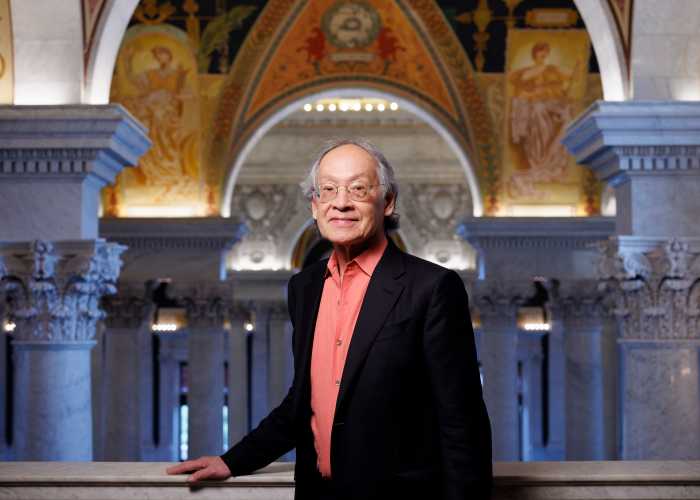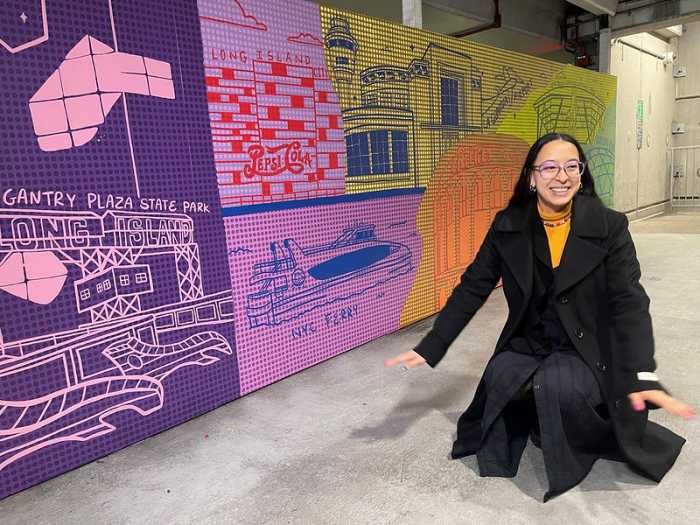Graffiti was a man’s world— until she painted it pink.
Lady Pink, graffiti’s first and fieriest female figurehead, still reigns supreme as an icon in the American art arena. While her medium switched from subway cars and cinderblock walls to canvas over the years, the Astoria-based creative is still spreading her message — art is everywhere.
Lady Pink, born Sandra Fabara, emerged on the scene in 1979, when girl power prevailed and the public worshipped fierce, feminine idols like Charlie’s Angels and Marsha Brady. Riding on pure personality and perseverance, at 16, she busted into the proverbial boys club, proclaiming that girls could do anything boys could do, only better. The older male artists adopted her as their little sister and influenced by her fixation on historical-romance novels, they bestowed upon her the intentionally girly and definitely regal moniker, “Lady Pink.”
In the early 1980s, she scaled fences and scrawled her designs on subway cars.
“It was all about the adventure and the fame,” she said. “It was less about the art then, it was just teenagers having fun.”
 She was expelled from the High School of Art & Design in Manhattan after some kids from the Bronx shot up the school during her first graffiti exhibit. While no one was killed, a stray bullet struck a kid in the back and injured him. After a heated argument with the principal and the dropping of a single f-bomb, Lady Pink’s show was shut down and she was told to leave school.
She was expelled from the High School of Art & Design in Manhattan after some kids from the Bronx shot up the school during her first graffiti exhibit. While no one was killed, a stray bullet struck a kid in the back and injured him. After a heated argument with the principal and the dropping of a single f-bomb, Lady Pink’s show was shut down and she was told to leave school.
She said she didn’t like school anyway, but went on to graduate from public school.
In 1982, Lady Pink starred in the film “Wild Style,” a graffiti hip-hop amalgamation that elevated her to cult figure status. Regardless of the seemingly inseparable connection between the musical genre and the art style, Lady Pink says it’s a lifestyle she never subscribed to.
“The grassroots beginning are connected,” she said. “Other than that, there is little we have in common. They lump us up as background art so it can be a nice complete culture that can be packaged and sold. The truth of the matter is most graffiti writers are only exposed to the music of the area they come from.”
While working, Lady Pink listens to The Beatles and Metallica.
Graffiti remains, according to Lady Pink, very much its own entity, retaining what she feels is an incredibly sexist attitude.
“My background grants me respect but I see other young ladies struggling to be heard and seen,” said Lady Pink. “We have to bust our butts twice as hard to be seen and noticed.”
When she and her husband, another prominent graffiti artist whose tags terrorized multiple mayors throughout the 1970s and 1980s, work together on projects for their professional muralist company, she has him deal with the overtly-macho and occasionally misogynistic contractors and construction workers. She believes it’s about playing the game and not fighting nature.
A lifetime of running the streets, she says, prepared her.
“Graffiti to us when we’re young is like what people go to college for,” she said. “It’s boot camp for artists — how to work fast — how to work with sharks at your throat. It’s how to survive in the real world.”
Even though a portion of the population still regards graffiti as a nuisance and an eyesore, Lady Pink believes the art form gained legitimacy through sheer exposure. The artist has shown work in countless galleries and museums including the Museum of Contemporary Art (MOCA) in Los Angeles and the MoMA PS1. Nevertheless, there are always people waiting below her scaffold, ranting about the bright colors of the mural she’s painting.
“I get robbed, I get insulted, I get harassed by the police,” she said. “I welcomed the invention of the Walkman. I put on my music and shut them out.”
Lady Pink mentioned the newly announced demise of 5Pointz – graffiti’s holy land, recently fated to be closed and turned into high-rise apartment buildings. She hopes the displaced artists will find artistic refuge somewhere else, but recognized the city’s shortcomings in artistic preservation.
“That’s progress in New York City,” she said. “All murals are fleeting. You paint it and kiss it goodbye.”
The loss, she says, will be devastating in the annals of art history.
In contributing to the continuity of art, Lady Pink teams with kids from the Frank Sinatra School for the Arts. They design and paint public murals around Astoria and Long Island City, covering walls under the Hell Gate Bridge with sweeping images from Greek myths.
“I put the kids in big situations because that’s what happened to me,” she said. “Kids perform better when they’re given responsibilities and tasks beyond their comprehensions — their confidence grows.”
She insists her apprentices bring their own music to listen to while they paint.
“Music makes better art,” said Lady Pink. “I don’t know how art can happen in the quiet.”
Together, they put on their headphones and drown out the noise of the world.




































